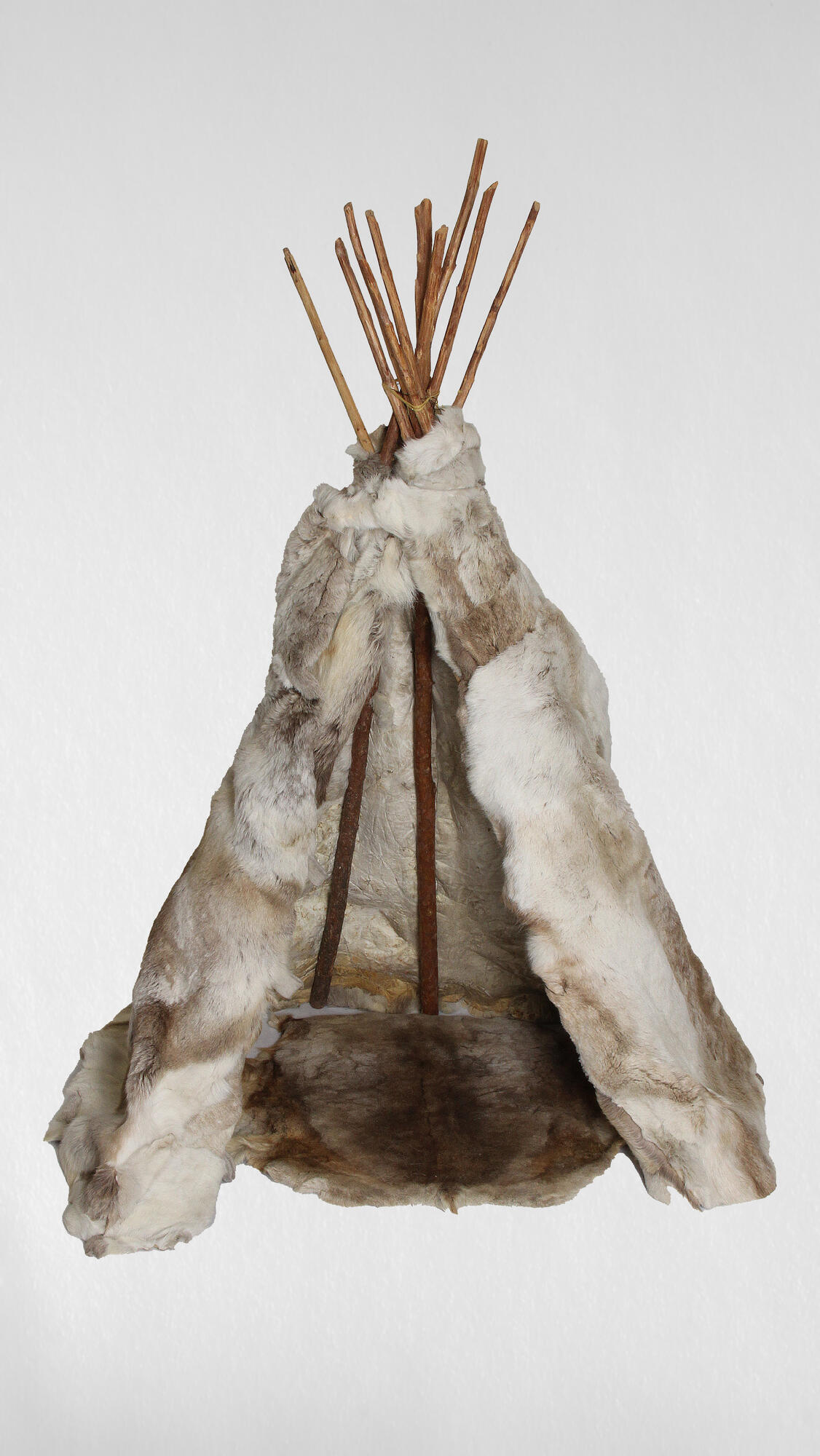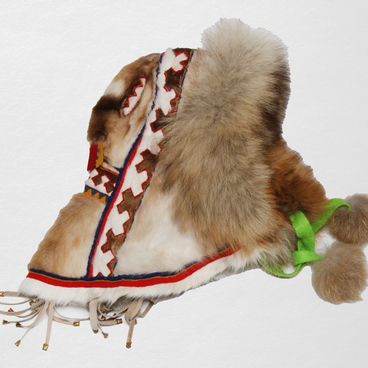The raw-hide tent, the dwelling of tundra nomads, belongs to the classical elements of reindeer herding. It is a large cone-shaped structure of poles and a roof with a hole for the smoke outlet on top.
The raw-hide tent was built from the poles that had sharp edges at the bottom and were harvested in the forest areas. One dwelling required 36–40 five-meter poles.
The size of the dwelling depended on the number of poles: the larger the frame was, the more spacious the raw-hide tent became. Its diameter, on average, reached 5–8 meters; such a dwelling could accommodate up to 20 people.
The poles were covered with “nyuki” — this is how the Nenets called the cloths made of reindeer skins. In winter, one raw-hide tent required 60–70 deer skins. The nyuki were sewn into solid cloths with reindeer tendon threads. Winter cover was considered valuable, and was treated with care: in the summer it was cleaned, dried, and repaired.
Every object and every place inside the raw-hide tent had its own purpose. The central axis of the dwelling was the simza pole, which the Nenets considered sacred. Behind it was the sacred space si, on which only older men could step. There was usually a chest with the patron spirits of the hearth, family, clan and locality.
Opposite the si, at the entrance, there was a nyo, the woman’s place. Here she did household chores: she sewed, repaired clothes and shoes, pulled threads from reindeer tendons, cooked food, served the table. A sleeping place was located between the si and the nyo.
The place for a new camp was determined by a man, who stuck a pole for steering reindeer into the ground or into the snow. Then the adults and children unharnessed the reindeer and cleared the place. The hearth iron sheet — the first thing at the base of the new raw-hide tent — was laid by a woman. In winter, two logs were necessarily placed under this sheet so that the snow did not melt.
On either side of the hearth sheet, several logs were laid which served as the floor. Mattings were put behind the boards, further away from the fire. Then the women put up the poles and fastened them at the top with an iron hoop of the chimney. The lower sharp-edged ends were dug into the snow or the ground.
After that, a pole for the boiler and kettle was installed: one end of it was attached to the simzy (sacred pole), and the other was tied to the entrance poles. An iron rod was placed across it, on which a hook was put on. A cauldron was hung on it.
The women pulled the skins on the poles that had been installed. They lifted sewn reindeer skins and laid them on the frame of the raw-hide tent, rolling them from top to bottom. From the inside, the nyuki were tied to poles, and from the outside they were pressed with poles or sledges, and additional snow on the top. The hinged part of the nyuk served as the door.
The raw-hide tent was disassembled in the reverse order. The women carried things out of the raw-hide tent, packed them in sacks, then took off the nyuki, collected the poles, the chimney and the hearth leaf. The men put parts of the raw-hide tent and things on the sledge and tied them, and then placed the sledge in the caravan called “argish”. To transport one raw-hide tent, it was necessary to use from 5 to 10 sledges.
The raw-hide tent was built from the poles that had sharp edges at the bottom and were harvested in the forest areas. One dwelling required 36–40 five-meter poles.
The size of the dwelling depended on the number of poles: the larger the frame was, the more spacious the raw-hide tent became. Its diameter, on average, reached 5–8 meters; such a dwelling could accommodate up to 20 people.
The poles were covered with “nyuki” — this is how the Nenets called the cloths made of reindeer skins. In winter, one raw-hide tent required 60–70 deer skins. The nyuki were sewn into solid cloths with reindeer tendon threads. Winter cover was considered valuable, and was treated with care: in the summer it was cleaned, dried, and repaired.
Every object and every place inside the raw-hide tent had its own purpose. The central axis of the dwelling was the simza pole, which the Nenets considered sacred. Behind it was the sacred space si, on which only older men could step. There was usually a chest with the patron spirits of the hearth, family, clan and locality.
Opposite the si, at the entrance, there was a nyo, the woman’s place. Here she did household chores: she sewed, repaired clothes and shoes, pulled threads from reindeer tendons, cooked food, served the table. A sleeping place was located between the si and the nyo.
The place for a new camp was determined by a man, who stuck a pole for steering reindeer into the ground or into the snow. Then the adults and children unharnessed the reindeer and cleared the place. The hearth iron sheet — the first thing at the base of the new raw-hide tent — was laid by a woman. In winter, two logs were necessarily placed under this sheet so that the snow did not melt.
On either side of the hearth sheet, several logs were laid which served as the floor. Mattings were put behind the boards, further away from the fire. Then the women put up the poles and fastened them at the top with an iron hoop of the chimney. The lower sharp-edged ends were dug into the snow or the ground.
After that, a pole for the boiler and kettle was installed: one end of it was attached to the simzy (sacred pole), and the other was tied to the entrance poles. An iron rod was placed across it, on which a hook was put on. A cauldron was hung on it.
The women pulled the skins on the poles that had been installed. They lifted sewn reindeer skins and laid them on the frame of the raw-hide tent, rolling them from top to bottom. From the inside, the nyuki were tied to poles, and from the outside they were pressed with poles or sledges, and additional snow on the top. The hinged part of the nyuk served as the door.
The raw-hide tent was disassembled in the reverse order. The women carried things out of the raw-hide tent, packed them in sacks, then took off the nyuki, collected the poles, the chimney and the hearth leaf. The men put parts of the raw-hide tent and things on the sledge and tied them, and then placed the sledge in the caravan called “argish”. To transport one raw-hide tent, it was necessary to use from 5 to 10 sledges.



